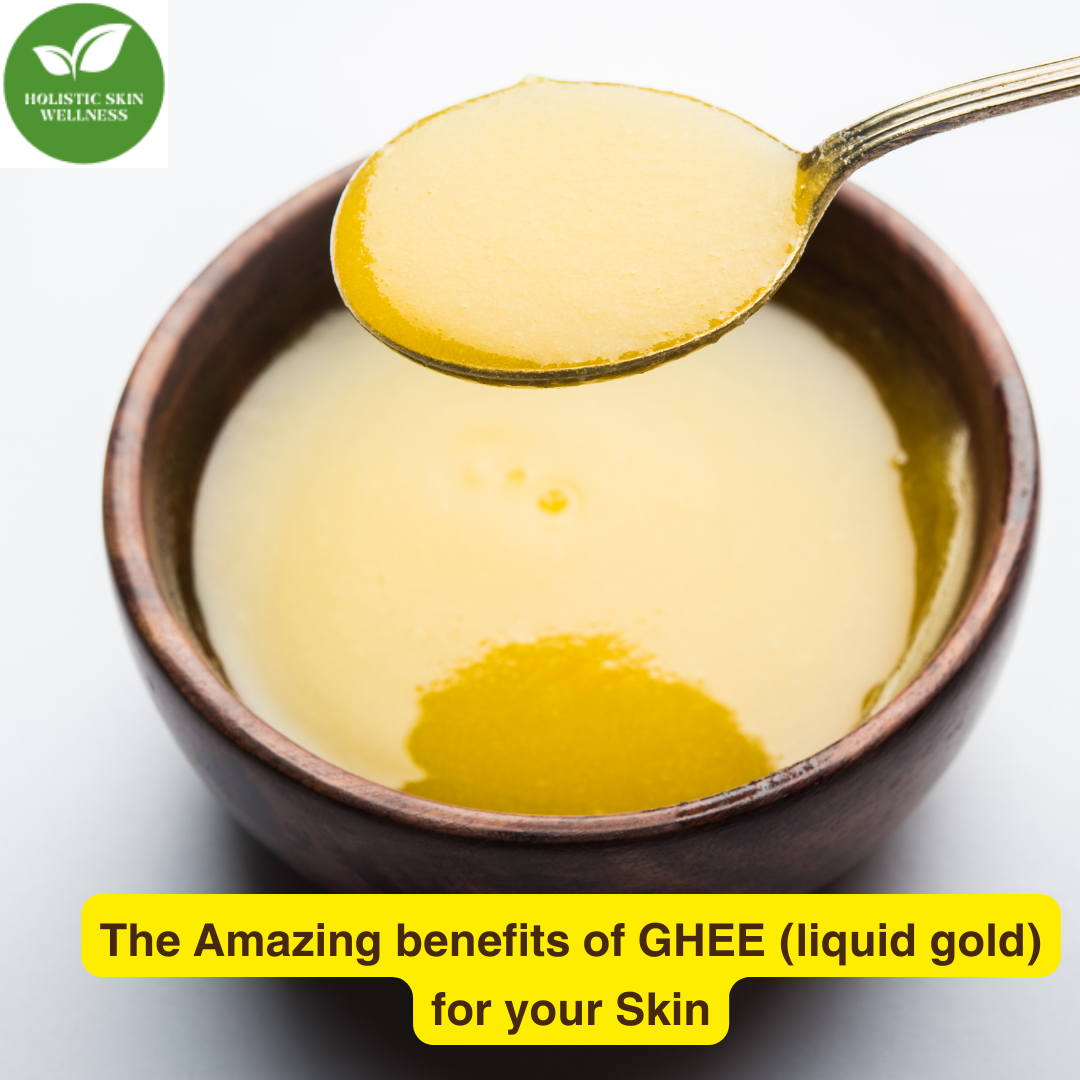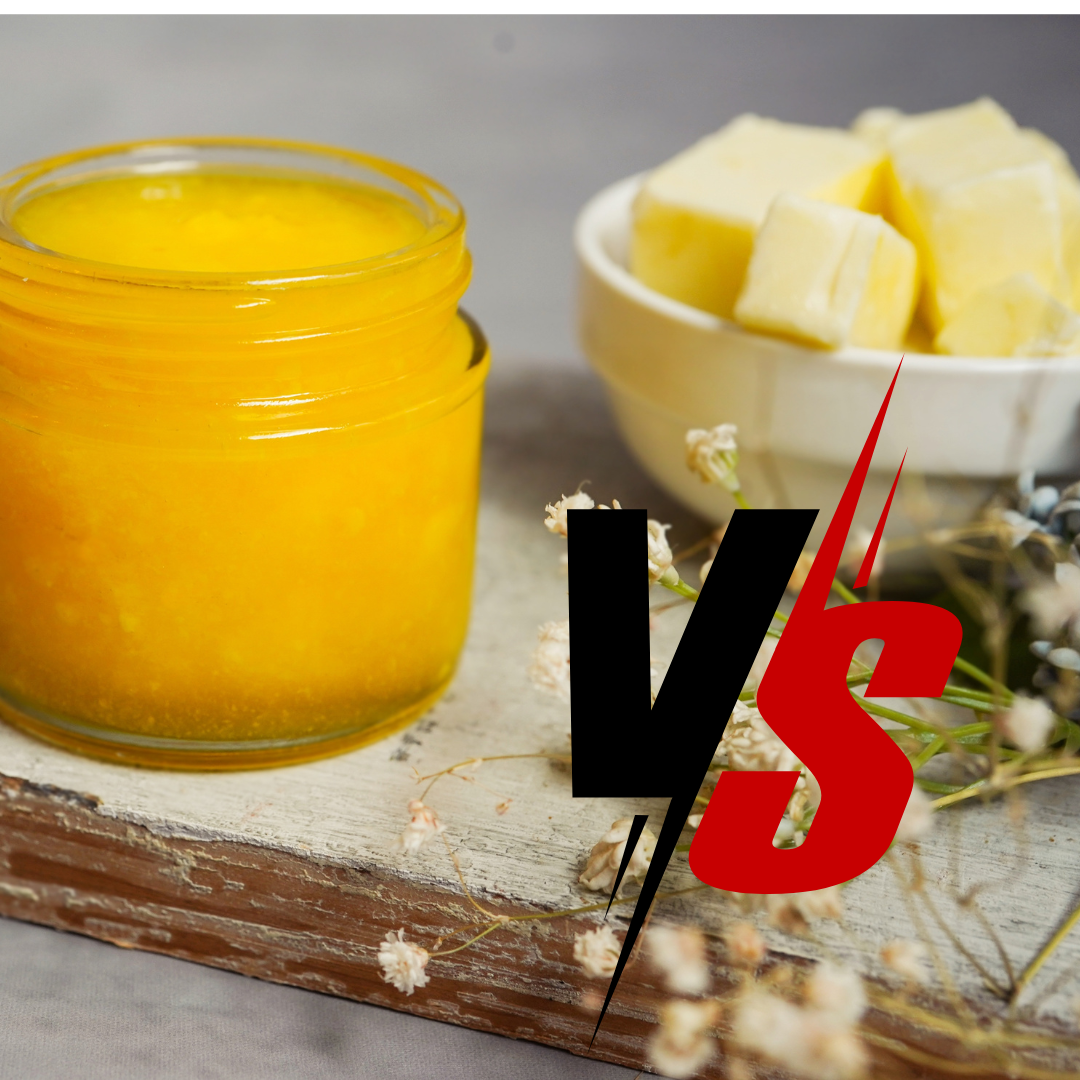
The Amazing benefits of GHEE (liquid gold) for your Skin
Ghee, also known as clarified butter, is a staple in traditional Indian cuisine and has been used for thousands of years in traditional medicines as a cooking oil and ingredient in various dishes and remedies.
Ghee is commonly used in Indian cooking for frying, sautéing, and making curries and other dishes. It is also added to traditional Indian sweets and desserts, such as halwa and ghee rice.
In Indian culture, Ghee is valued for its rich, creamy flavor and cultural and historical significance. It is believed to have various health benefits, such as supporting digestion and promoting overall health, and is considered a staple in many Indian households.
It is made by removing the milk solids and water from butter, which leaves behind a golden oil rich in antioxidants and healthy fats.
Ghee is considered good for the Skin for several reasons:
For skin health, Ghee is known for its moisturizing properties, as it can help hydrate and nourish the Skin.
- Hydrating: Ghee is an excellent moisturizer, as it contains saturated fatty acids that help to keep the Skin hydrated and prevent dryness.
- Anti-inflammatory: Ghee contains antioxidants and anti-inflammatory compounds, such as butyric acid and conjugated linoleic acid, that can help to reduce redness, swelling, and other symptoms of skin inflammation.
- Nourishing: Ghee is rich in vitamins and minerals, such as vitamin A, vitamin E, and iron, that are important for skin health and can help to keep Skin looking youthful and radiant.
- Antimicrobial: Ghee also has antimicrobial properties, which can help to protect the Skin from harmful bacteria, yeast, and other microorganisms that can cause skin infections and other skin conditions.
- Anti-inflammatory: It is also believed to have anti-inflammatory effects, which can help reduce redness and irritation in some skin conditions.
It’s important to note that not everyone’s Skin reacts the same way to topical Ghee, and some people may experience skin irritation or other adverse reactions. It’s best to perform a patch test on a small area of Skin before using Ghee on a larger scale and to consult a dermatologist if you have any concerns.
Ghee Vs Butter

Ghee is considered by some to be a healthier alternative to butter due to the following reasons:
- High smoke point: Ghee has a higher smoke point than butter, which means it can be used at higher temperatures for cooking and baking without burning.
- Lactose and casein-free: Ghee is made by simmering butter to remove the milk solids and water, resulting in a lactose and casein-free product. This makes it a good option for those who are lactose intolerant or have a casein allergy.
- Nutrient-rich: Ghee is a rich source of certain nutrients, including vitamin A and vitamin E, which are essential for Skin, eye, and immune health.
- Anti-inflammatory: Ghee is a source of butyric acid, a short-chain fatty acid that has been shown to have anti-inflammatory and antimicrobial effects.
How to make Ghee
Making Ghee is a simple process requiring two ingredients: butter and a saucepan. Here’s how to make Ghee:

Ingredients:
- 1 pound (450 grams) of unsalted butter
Instructions:
- Cut the butter into small pieces and place it in a saucepan over medium heat.
- As the butter melts, it will begin to boil and produce foam. Use a spoon to remove the foam from the surface of the butter.

- As the foam subsides, the butter will begin to simmer. Keep the heat at medium and allow the butter to simmer for about 10-15 minutes or until the milk solids start to separate from the oil.

- Once the milk solids have separated, use a fine mesh strainer or cheesecloth to strain the Ghee into a heat-proof glass jar. Discard the solids.
- Let the Ghee cool to room temperature, then cover the jar and store it in a cool, dark place.
And that’s it! Your Ghee is now ready to use, and it will keep for several months at room temperature, or you can store it in the refrigerator for longer shelf life.
Enjoy!
How to use Ghee on your Skin
Ghee can be used on the Skin in several ways to nourish and hydrate the Skin:
- Moisturizer: Ghee can be used as a moisturizer or as a carrier oil for essential oils. Simply massage a small amount of Ghee into the Skin, focusing on dry areas, and allow it to soak in for a few minutes.
- Face mask: Mix ghee with honey, turmeric, to create a nourishing face mask. Apply the mask to the Skin, leaving it on for 15-20 minutes before rinsing it off with warm water.
- Lip balm: Ghee can be used as a lip balm to hydrate and soothe dry, chapped lips. Simply apply a small amount of Ghee to the lips as needed.
- Body oil: Ghee can be used as a body oil to hydrate and nourish the Skin. Massage a small amount of Ghee into the Skin after showering or bathing for best results.
It’s important to patch test ghee on a small skin area before using it on a larger scale, to avoid any skin irritation or other adverse reactions.
Why should you definitely include Ghee in your diet?

Ghee has been used in traditional Ayurvedic medicine for thousands of years and has been touted as a beneficial food for overall health. Some of the potential health benefits of Ghee include:
- Heart health: Ghee is a rich source of conjugated linoleic acid (CLA), a type of fatty acid that has been shown to have beneficial effects on heart health.
- Immune system: Ghee is a source of butyric acid, a short-chain fatty acid shown to have anti-inflammatory and antimicrobial effects, which may support the immune system.
- Digestion: Ghee is easy to digest and can help to soothe and lubricate the digestive tract, making it a good option for those with digestive issues.
- Skin health: Ghee is a rich source of vitamins A and E, essential for skin health, and can be used topically on the Skin to hydrate and nourish the Skin.
- Brain health: Ghee has been touted as a possible benefit for brain health due to its high levels of specific fatty acids, such as butyric acid and conjugated linoleic acid (CLA). These fatty acids are thought to have anti-inflammatory and neuroprotective effects that may support brain health.
In addition, Ghee is a rich source of medium-chain triglycerides (MCTs), a type of saturated fat easily metabolized by the body and used for energy. Some studies have shown that MCTs improve cognitive function and mental clarity.

Ghee is a versatile ingredient used in various ways in cooking and baking. Here are some ways to consume Ghee:
- Cooking: Ghee is a great cooking oil with a high smoke point and a rich buttery flavor. It can be used to sauté vegetables, cook eggs, or substitute butter or oil in any recipe.
- Baking: Ghee can be used in place of butter in baking recipes, such as cakes, cookies, and bread.
- Drizzling: Ghee can be drizzled over hot cereal, rice, or vegetables for added flavor and nutrition.
- Supplement: Some people take a spoonful of Ghee daily as a supplement for its potential health benefits.
- Tea: Ghee can be added to tea or coffee for a rich, creamy flavor and added nutrition.
It’s essential to remember that Ghee is a rich source of saturated fat and should be consumed in moderation as part of a balanced diet. It’s also best to opt for high-quality, organic Ghee to ensure the best nutritional value and to minimize the risk of harmful additives.
I hope you liked this blog; remember to like, subscribe & share!
If you are dealing with a chronic skin issue and want to know how I can help you, feel free to email me.
I can assess your condition and provide a comprehensive holistic treatment plan, including any necessary herbal prescriptions, therapies, nutritional plan & lifestyle upgrades to heal your skin from inside out!
